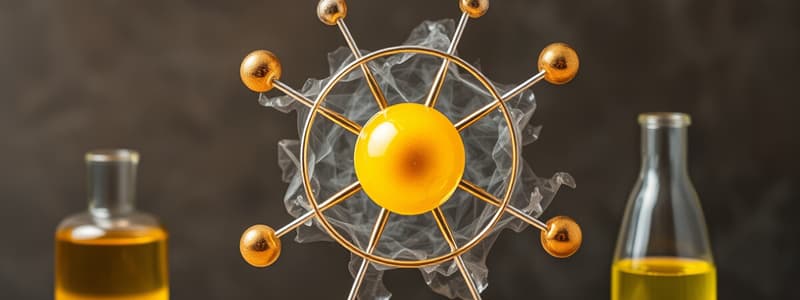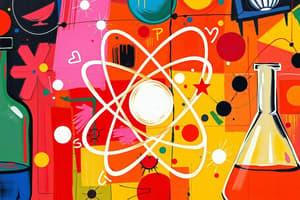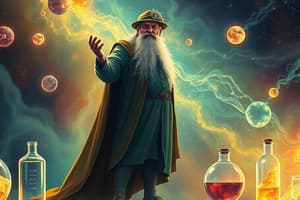Podcast
Questions and Answers
Who first named the smallest piece of matter 'atomos'?
Who first named the smallest piece of matter 'atomos'?
- JJ Thompson
- Ernest Rutherford
- Democritus (correct)
- John Dalton
All atoms of a given element are identical in mass and properties according to Dalton's Atomic Theory.
All atoms of a given element are identical in mass and properties according to Dalton's Atomic Theory.
True (A)
What did J.J. Thompson discover?
What did J.J. Thompson discover?
Electrons
What is the maximum number of electrons in the 3rd shell?
What is the maximum number of electrons in the 3rd shell?
What is the atomic number?
What is the atomic number?
An atom with the same proton number but different neutron number is called an __________.
An atom with the same proton number but different neutron number is called an __________.
Match the following scientists with their contributions:
Match the following scientists with their contributions:
The law of conservation of mass states that mass is created in chemical reactions.
The law of conservation of mass states that mass is created in chemical reactions.
What do valence electrons represent?
What do valence electrons represent?
What is a physical property?
What is a physical property?
The three states of matter are __________, liquid, and gas.
The three states of matter are __________, liquid, and gas.
Flashcards are hidden until you start studying
Study Notes
Atoms and Atomic Theory
Democritus
- Greek philosopher who named the smallest unit of matter "atomos," meaning "not to be cut."
- Proposed that atoms are small, hard particles of the same material, varying in shape and size.
- Believed in an infinite number of atoms.
Dalton’s Atomic Theory
- All matter consists of atoms, which are indivisible.
- Atoms of the same element have identical mass and properties.
- Atoms of different elements vary in properties.
- Chemical reactions rearrange atoms, forming new substances.
Historical Models of the Atom
John Dalton (1803)
- Coined the term "atom," derived from Greek, meaning "indivisible."
- Stated that atoms are indivisible and elements are identical; compounds consist of different atoms.
J.J. Thomson (1904)
- Proposed the Plum Pudding Model, where electrons are distributed in a positively charged "soup."
- Discovered the electron, demonstrating that atoms contain smaller particles.
Ernest Rutherford (1911)
- Developed the Nuclear Model, revealing that atoms consist of a small, dense nucleus containing protons.
- Introduced the quantum mechanical model, indicating electrons occupy specific energy levels, calculated by 2n².
Niels Bohr (1913)
- Proposed the Planetary Model, where protons and neutrons are in the nucleus, and electrons orbit at fixed distances and energies.
- Modified Rutherford’s model, emphasizing distinct energy levels.
Erwin Schrödinger (1926)
- Present the Wave Model, stating electrons behave as both particles and waves.
- His model is recognized as the most accurate representation of atomic structure.
Properties of Subatomic Particles
Electrons
- Negatively charged particles located around the nucleus.
Protons
- Positively charged particles located within the nucleus.
Neutrons
- Neutral particles situated in the nucleus.
Isotopes
- Variants of atoms with the same number of protons but differing numbers of neutrons.
Isotope Notation
- Displays additional information, including mass and atomic numbers.
Key Isotopes
- Tritium, Deuterium, Protium.
Electron Configuration
Valence Electrons
- Electrons in the outermost shell involved in chemical bonding.
Aufbau Principle
- Describes the process for establishing the electronic configuration of atoms or ions.
Hund’s Rule and Pauli Exclusion Principle
- Hund’s Rule addresses maximum multiplicity in electron configurations.
- Pauli Exclusion Principle states no two electrons can share the same four quantum numbers.
Quantum Numbers
- Define properties of atomic orbitals and their associated electrons.
Four Types of Quantum Numbers
- Principal Quantum Number (n): Indicates main energy levels.
- Orbital Quantum Number (l): Defines shape of orbital (S=0, P=1, D=2, F=3).
- Magnetic Quantum Number (ml): Describes orientation in space.
- Spin Quantum Number (ms): Indicates electron spin (+1/2 or -1/2).
Fundamental Chemical Laws
Antoine Lavoisier
- Advocated measurement as a core aspect of chemistry.
Law of Conservation of Mass
- States mass cannot be created or destroyed in a chemical reaction.
Law of Definite Proportions
- Each compound contains elements in fixed mass ratios, demonstrating consistency in composition.
John Dalton’s Contribution
- Emphasized that compounds have a consistent atomic makeup.
Law of Multiple Proportions
- When two elements form multiple compounds, the mass ratios of the second element with respect to the first can be expressed as small whole numbers.
Properties of Matter
Matter
- Defined as anything that occupies space and has mass, including air, glass, and other substances.
Composition of Matter
- Refers to the types and quantities of simpler substances comprising a material.
Substance
- A type of matter with a defined and fixed composition.
Properties
- Characteristics unique to each substance, which help identify it.
Physical Properties
- Observable traits that do not change a substance’s identity.
Physical Change
- A transformation affecting appearance without altering composition.
Chemical Properties
- Traits shown during interactions with other substances.
States of Matter
Solid
- Maintains a fixed shape and structure; particles are closely packed and organized.
Liquid
- Adopts the shape of its container up to its volume; particles are close but disorganized.
Gas
- Fills the entire container, lacking a defined shape; particles are far apart and move freely.
Studying That Suits You
Use AI to generate personalized quizzes and flashcards to suit your learning preferences.




